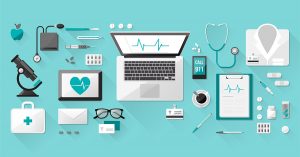
As many of us know, the healthcare industry is critical to helping our society prevent and recover from illnesses and diseases. Learning as much about causes, symptoms, and prognoses of illnesses is the best way healthcare professionals can help patients in need. Given that time is taken away from patients when having to go to a classroom, eLearning provides a way for healthcare professionals to be knowledgeable of the latest developments in treatments and diagnoses. There are many other advantages as well. Here are 5 important benefits of using eLearning in the Healthcare industry.
1. eLearning can be done anywhere
Healthcare professionals often don’t receive the continued learning they need because of a lack of access. After a day or night of working at a medical facility, it can be impossible for some professionals to attend classes. Additionally, the schedule of a medical professional can be unpredictable, making attending class at a regularly scheduled time difficult. The use of eLearning can provide an opportunity for studying to be done at home, in the office, or while on the go. A healthcare worker can access the material on their smartphone, tablet, or laptop as long as there’s an internet connection available. With the material being available anytime, workers can access it at their own convenience, and progress through courses at a pace that works best for them.

2. It can be more effective than traditional learning
There’s a perception that because eLearning allows people to access learning material from anywhere, that the material is too easy and there’s not enough of it being provided. There’s also concern that students may miss out on critical benefits from discussing the material inside a classroom setting. Nonetheless, the World Health Organization concluded that eLearning for healthcare professionals can be just as effective if not more than traditional learning. It’s likely because of the many features that are included within eLearning systems. Among them include text, worksheets, audio, and videos. Discussion boards are also provided, which can allow students to bring up ideas related to certain topics with other students, similar to interactions that would occur in a classroom.
3. It’s less expensive
There’s a high expense to facilitating traditional learning methods. Institutions have to pay for the trainer, the learning materials, and the location where the training will take place. All of these elements can cost thousands of dollars. There’s also a cost of productivity, because professionals will have to spend a day or more away from caring for their patients. eLearning is decidedly less expensive. All of the required materials are already available to the user through their desktop, tablet, smartphone, or laptop. Training centers do not need to be reserved, and professionals can take time to learn the material at a time when they’re not caring for their patients. A healthcare professional can maintain their productivity at work and get the necessary education they need to continue to improve in providing the best care for their patients.

4. eLearning offers a resource
A database is provided in eLearning systems to help answer questions that healthcare professionals may have. There may be a topic that they might remember reading about in one of the modules but have forgotten some of the details of. With an eLearning system, it only takes minutes for a healthcare professional to find the answers they need by logging in and going to the module. In addition to the modules, eLearning systems also feature search engines that can be used to find more information. These tools can help simplify the process of finding what’s needed. Additionally, healthcare facilities may add sections in the system that have updates on information that a user has already learned. They can also use it to inform users of any news about the facility.
5. It’s useful for all learning types
Everyone has a different style when it comes to learning. Some people learn best through reading or listening, while others are more visual learners. An eLearning system includes text, audio files, images, and videos. It’s useful for individuals who don’t learn as well in classrooms due to lectures not using as many videos or images. If you plan to include audio files in the system, it’s important to make sure they’re of good quality. In my work as a voice artist, I use professional recording equipment to eliminate any background noise or other distracting sounds that can make listening and learning difficult. I also communicate in a pleasant tone that’s comfortable for the listener to hear.
Through eLearning, a user can take as much time as they need to properly learn the information. It not only benefits learners who need to take things slower, but it also benefits learners who understand the material faster by allowing them to move through the modules at a quick pace. Learners being able to learn in their own way helps them to be more certain they’re absorbing the information, which is critical to properly caring for patients when they’re working.
These are a few of many benefits that eLearning can provide for healthcare professionals. It’s important to continually find effective ways to keep your workers knowledgeable in the best current methods of caring for their patients. An eLearning system can be an effective tool you can utilize to accomplish that goal.

